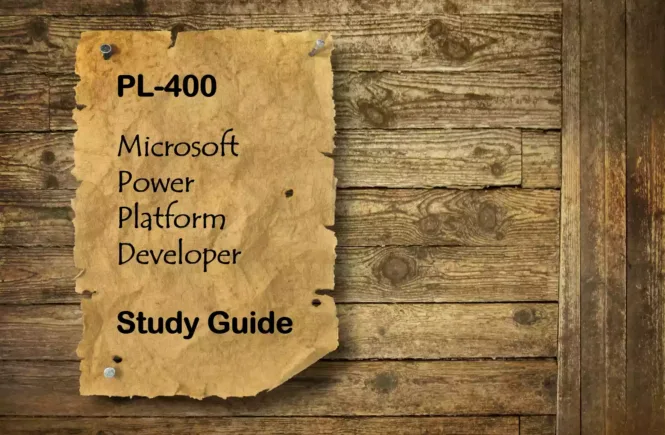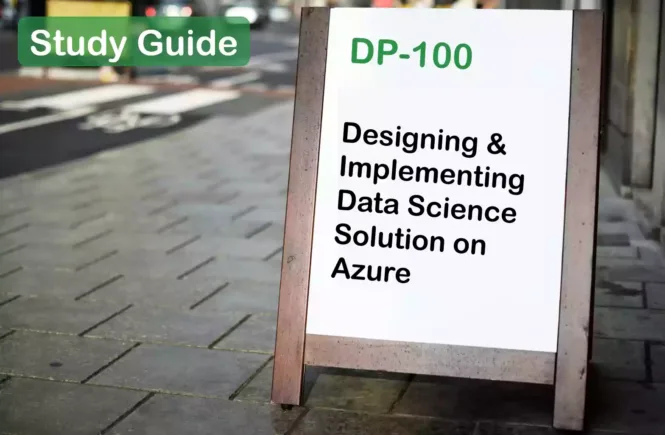How to Prepare for the PL-400 Exam?
Preparing for the PL-400 Microsoft Power Platform Developer Certificate exam? Don’t know where to start? This post is the PL-400 Certificate Study Guide (with links to each exam objective).
I have curated a list of articles from Microsoft documentation for each objective of the PL-400 exam. I hope this article will help you to achieve the PL-400 Microsoft Power Platform Developer Associate Certification. Also, please share the post within your circles so it helps them to prepare for the exam.
Exam Voucher for PL-400 with 1 Retake
Get 40% OFF with the combo
PL-400 Microsoft Power Platform Developer
| Pluralsight (Free Trial) | Building and Administering PowerApps |
| LinkedIn Learning | Microsoft Power Platform Foundations |
PL-400 MS Power Platform Developer Test
| Whizlabs Exam Questions | Power Platform Developer Practice Test |
| Udemy Practice Test | Microsoft Power Platform Developer Exam |
| Amazon (e-book) | Power Platform Developer Q&A + Guide |
Looking for PL-400 Dumps? Read This!
Using PL-400 exam dumps can get you permanently banned from taking any future Microsoft certificate exam. However, I strongly suggest you validate your understanding with practice questions.
Check out all the other Power Platform certificate study guides
Full Disclosure: Some of the links in this post are affiliate links. I receive a commission when you purchase through them.
Create a Technical Design (10-15%)
Validate Requirements and Design Technical Architecture
Design and validate the technical architecture for a solution
Design phase: Planning a Power Apps project
Power Apps architectural design
Determining which type of app to make
Design authentication and authorization strategy
Get started with configuring your authentication
Implementing Role-based security in your Power Apps
Determine whether you can meet requirements with out-of-the-box functionality
Introducing the PowerApps Center of Excellence starter kit
Determine when to use Logic Apps versus Power Automate flows
Compare Microsoft Power Automate & Logic Apps
Determine when to use serverless computing, plug-ins, or Power Automate
Choose the right integration & automation service
Determine when to build a virtual entity data source provider and when to use connectors
Get started with virtual entities
Overview of connectors for Power Apps
Amazon link (affiliate)
Design Solution Components
Design a data model
Data modeling: Designing your data structure
Design Power Apps reusable components
Create a component for canvas apps
Design custom connectors
Create a custom connector from scratch
Custom connectors for canvas apps
Design server-side component
Describe Power Platform Extensibility Points
Describe Power Virtual Agents extensibility points including Bot Framework skills and Power Automate flows
Extend Power Virtual Agents using Bot Framework Skills
Use Power Virtual Agents Connector to build Power Automate flows
Describe Power BI extensibility points including Power BI APIs, custom visuals, and embedding Power BI apps in websites and other applications
Extend Power BI with custom visuals
Embed a report in a secure portal or website
Describe Power Apps portal extensibility points including CRUD APIs and custom styling
Web APIs for CRUD operations on Common Data Service entities
Describe Web Resources and their uses
Web resources in model-driven apps
Configure Microsoft Dataverse (15-20%)
Configure Security to Support Development
Troubleshoot operational security issues
Security concepts in Microsoft Dataverse
Troubleshooting: Common user access issues
Create or update security roles and field-level security profiles
Get started with security roles in Dataverse
Field-level security to control access
Add teams or users to a field security profile to control access
Configure business units and teams
Assign a business unit to a different parent business
Implement Entities and Fields
Configure entity and entity options
Create and manage tables in Dataverse
Configure fields
Create and manage fields within an entity in Dataverse
Configure relationships and types of behaviors
Create a relationship between tables
Implement Application Lifecycle Management (ALM)
Create solutions and manage solution components
Import and export solutions
Additional things to consider for import/export
Manage solution dependencies
Check for solution component dependencies
Dependency tracking for solution components
Create a package for deployment
Create packages for the Package Deployer tool
Automate deployments
Automate deployment using GitHub Actions for Power Platform
Implement source control for projects including solutions and code assets
Source control with solution files
Create and Configure Power Apps (15-20%)
Create Model-driven Apps
Configure a model-driven app
Build your first model-driven app from scratch
Configure forms
Create a model-driven app quick create forms
Configure views
Create a public or system model-driven app views
Configure visualizations
Create a visualization (chart)
Configure commands and buttons
Customize commands and the ribbon
Create Canvas Apps
Create and configure a canvas app
Create a canvas app from scratch using Microsoft Dataverse
Implement complex formulas to manage control events and properties
Get started with canvas-app formulas in Power Apps
Author an advanced formula in a canvas app in Power Apps
Configure a control in the formula bar
Analyze app usage by using App Insights
Analyze app telemetry using Application Insights
Instrument your canvas apps with Azure Application Insights
Log telemetry for your Apps using App Insights
Build reusable component libraries
Create a component library for canvas apps
Manage and Troubleshoot Apps
Troubleshoot app issues by using Monitor and other browser-based debugging tools
Introducing Monitor to debug apps & improve performance
Debugging canvas apps with Monitor
Use Monitor to troubleshoot model-driven app form behavior
Interpret results from App Checker and Solution Checker
Use Solution Checker to validate your model-driven apps
Identify and resolve connector and API errors
Troubleshooting Flow Custom Connectors
Handle errors from a PowerApps custom connector
Optimize app performance including pre-loading data and query delegation
Understand delegation in a canvas app
Performance considerations with PowerApps
Best practices to improve canvas app performance
Configure Business Process Automation (5-10%)
Configure Power Automate
Create and configure a flow
Get started with Power Automate
Create a cloud flow in Power Automate
Configure steps to use Dataverse connector actions and triggers
Create an automated flow by using the Dataverse connector
Implement complex expressions in flow steps
Use expressions in conditions to check multiple values
Build more powerful conditions in flows
Implement error handling
Error handling steps in Power Automate
Advanced error handling with Power Automate
Troubleshoot flows by analyzing JSON responses from connectors
Troubleshooting Flows in Microsoft Power Automate
Implement Processes
Create and configure business process flows
Create a business process flow to standardize processes
Enhance business process flows with branching
Create and configure business rules
Create business rules to apply logic in a model-driven app
Define and create business rules in Dataverse
Create, manage, and interact with business process flows by using server-side and client-side code
Work with business process flows using code
Sample: Work with business process flows
Troubleshoot processes
Extend the User Experience (10-15%)
Apply Business Logic Using Client Scripting
Create JavaScript or TypeScript code that targets the XRM API
Client API Reference for model-driven apps
Apply business logic using client scripting using JS
Web API Functions and Actions Sample (Client-side JS)
Register an event handler
Configure model-driven app event handlers
Add event handler function to an event using code
Create client-side scripts that target the Dataverse Web API
Client-side JavaScript using Web API in model-driven apps
Web API Functions and Actions Sample (Client-side JS)
Create a Power Apps Component Framework (PCF) Component
Describe the PCF component lifecycle
Power Apps component framework overview
Understanding PCF and control lifecycle
Initialize a new PCF component
Create and build a code component
Configure a PCF component manifest
Implement the component interfaces
Unified Interface for everybody
Package, deploy, and consume the component
Publish code components on AppSource
Configure and use PCF Device, Utility, and WebAPI features
Implementing Web API component
Test and debug PCF components by using the local test harness
Create a Command Button Function
Create commands
Design command button rules and actions
Customize commands and the ribbon
Define custom actions to modify the ribbon
Edit the command bar by using the Ribbon Workbench
Customize commands and the ribbon
Manage dependencies between JavaScript libraries
Extend the platform (15-20%)
Create a Plug-in
Describe the plug-in execution pipeline
Design and develop a plug-in
Debug and troubleshoot a plug-in
Implement business logic by using pre and post images
Perform operations on data by using the Organization service API
Using the Organization Service
Use the Microsoft Dataverse Organization Service
Modify your code to use global Discovery Service
Optimize plug-in performance
View plug-ins analytics in the dashboard
Register custom assemblies by using the Plug-in Registration Tool
Develop a plug-in that targets a custom action message
Use Workflow Custom Actions with code
Create Custom Connectors
Create a definition for the API
Create a custom connector from scratch
Create a custom connector from an OpenAPI definition
Configure API security
Use Azure Active Directory with a custom connector
Use policy templates to modify connector behavior at runtime
Dynamically change custom connector values with Policy Templates
Expose Azure Functions as custom connectors
Create a Custom Connector for Azure Functions
Using custom connectors to call Azure Functions
Create custom connectors for public APIs by using Postman
Create a custom connector from a Postman collection
Use Platform APIs
Interact with data and processes by using the Dataverse Web API or the Organization Service
Use the Microsoft Dataverse Web API
Perform operations using the Web API
Implement API limit retry policies
Optimize for performance, concurrency, transactions, and batching
Transaction Currency (currency) entity
Execute batch operations using the Web API
Query the Global Discovery service to discover the URL and other information for an organization
Discover the URL for your organization using the Web API
Perform entity metadata operations with the Web API
Query metadata using the Web API
Perform authentication by using OAuth
Use OAuth with Microsoft Dataverse
Process Workloads
Process long-running operations by using Azure Functions
Create a long-running serverless workflow with Durable Functions
Configure scheduled and event-driven function triggers in Azure Functions
Create a function in the Azure portal that runs on a schedule
Event-driven applications with Azure Functions
Authenticate to the Power Platform by using managed identities
Use Managed Identity to authenticate your Stream Analytics job to Power BI
Develop Integrations (5-10%)
Publish and Consume Events
Publish an event by using the API
Use the Microsoft Dataverse Web API
Publish an event by using the Plug-in Registration Tool
Register service endpoints including webhooks, Azure Service Bus, and Azure Event Hub
Use webhooks to create external handlers for server events
Register an Azure-aware plug-in using the Plug-in Registration Tool
Work with Dataverse event data in your Azure Event Hub solution
Implement a Dataverse listener for an Azure solution
Write a listener application for an Azure solution
Write a Service Bus Event Listener that consumes Dataverse messages
Create an Azure Function that interacts with Power Platform
Using Azure Functions in Power Apps
Integrating Azure Functions and Canvas Apps
Implement Data Synchronization
Configure entity change tracking
Use change tracking to synchronize data with external systems
Read entity change records by using platform APIs
Retrieve an entity record using the Web API
Create and use alternate keys
Define alternate keys using the Power Apps portal
This brings us to the end of the PL-400 Microsoft Power Platform Developer Study Guide.
What do you think? Let me know in the comments section if I have missed out on anything. Also, I love to hear from you about how your preparation is going on!
In case you are preparing for other Power Platform certification exams, check out the Power Platform study guides for those exams.
Follow Me to Receive Updates on PL-400 Exam
Want to be notified as soon as I post? Subscribe to the RSS feed / leave your email address in the subscribe section. Share the article to your social networks with the below links so it can benefit others.




